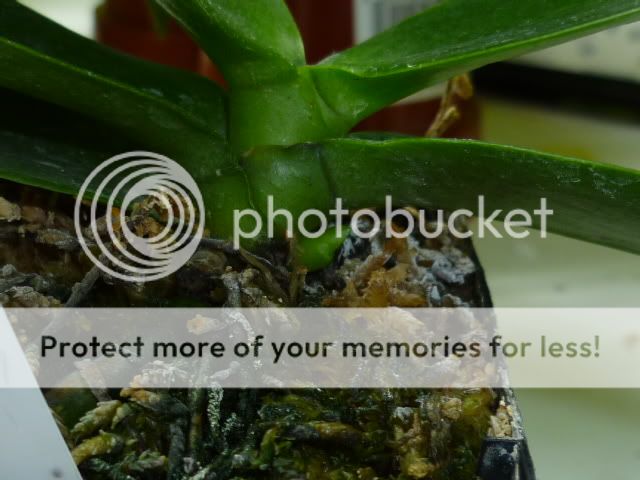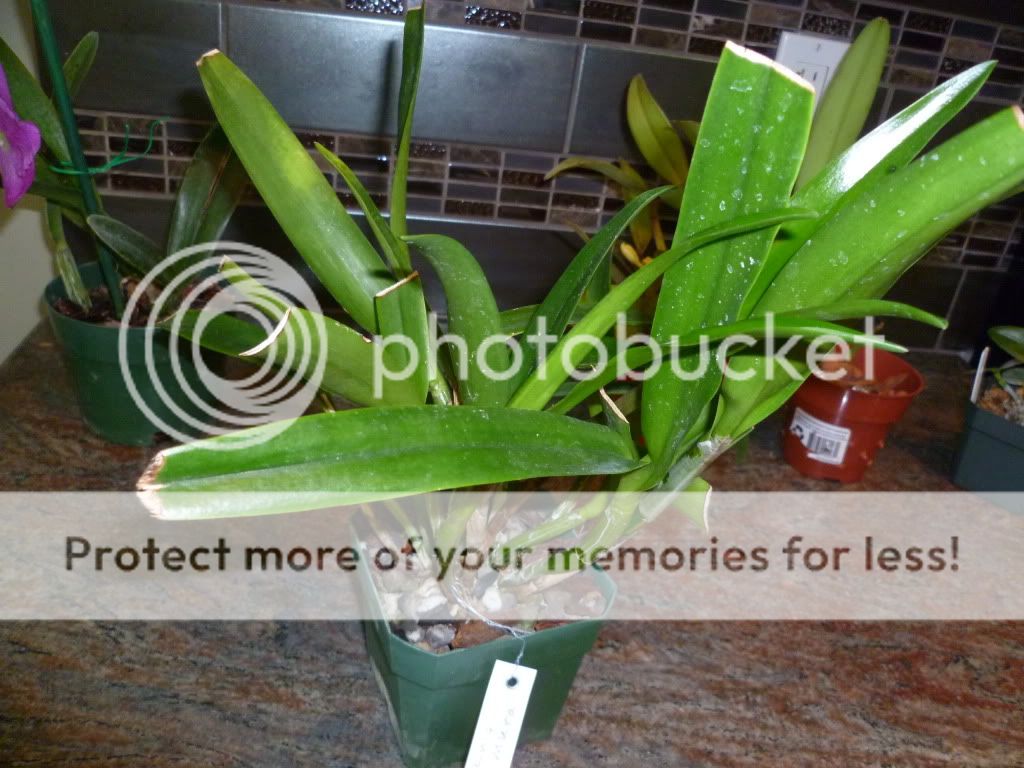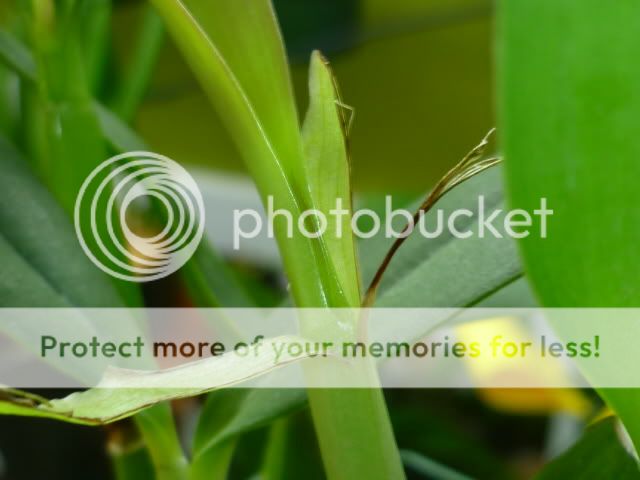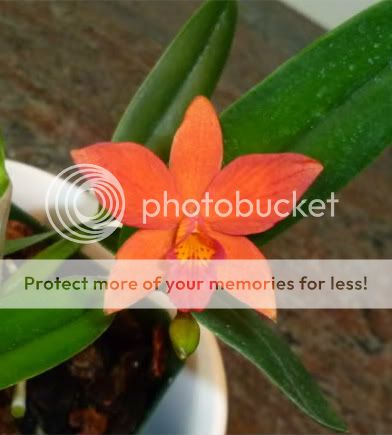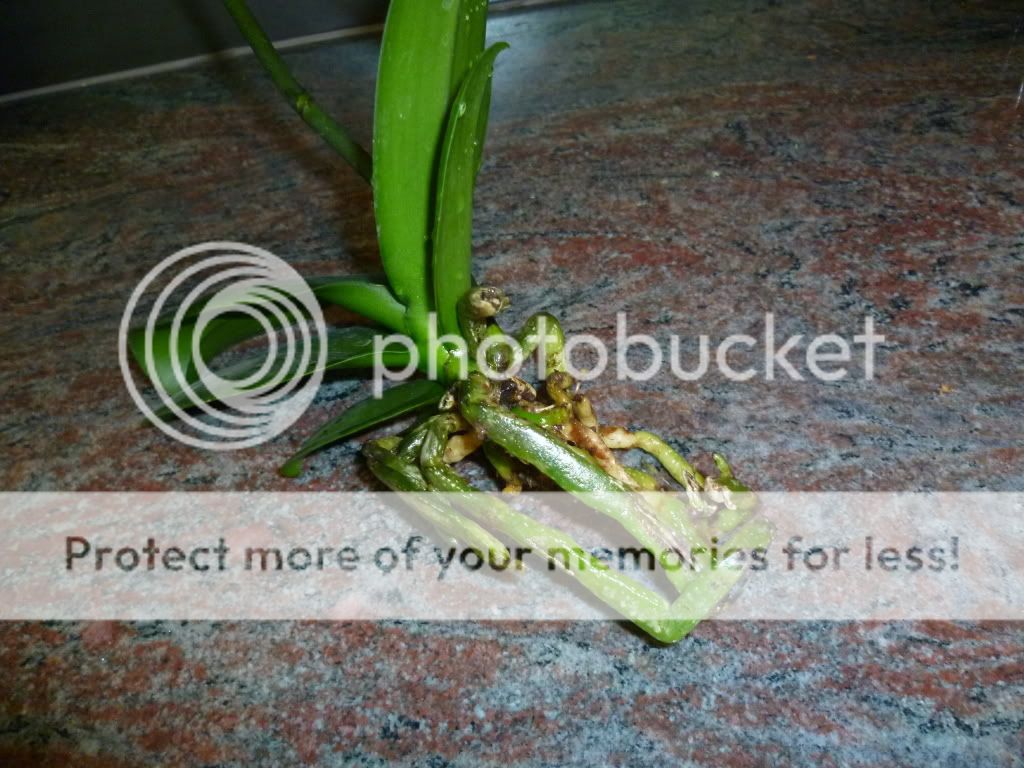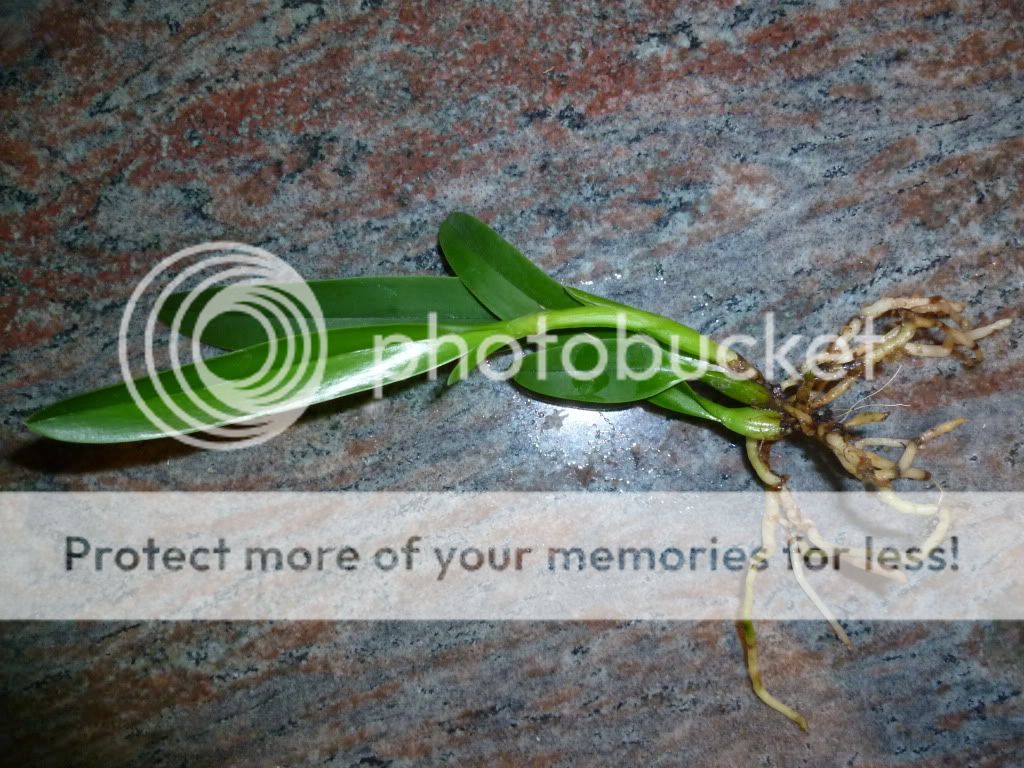My Onc. Gold Dust is getting closer to blooming! The previous p'bulb also started a new growth.
And finally, my B. Grand Stars '#2'. It is really close to opening, I think maybe within a week or so.
December 31, 2011
Spike progress!
YAY!!! It won't be long before I am enjoying blooms!!!
Here is the NoID with buds beginning to show.
Phal. ATL Crossing, just starting to show buds on its fat spike.
Phal. (Tying Shin Cupid x Super Stupid) with its two spikes! My goodness, I am going to have a show with this one!
Here is the new one.
Phal. Mambo
Phalaenopsis speciosa v. christiana. Sigh, this is one absolutely crazy phal! I think in total, it has 15 inflorescences and side spikes. Now, just to get them all to bloom at once. . . .
My Tolumnia is just finishing up its newest lead, which means its time for it to spike! I'm not sure if all Tolumnias do this, but this one starts a new growth, spikes when it is just about to finish the lead, finishes blooming, and then after a very brief rest, starts over again!
Here is the NoID with buds beginning to show.
Phal. ATL Crossing, just starting to show buds on its fat spike.
Phal. (Tying Shin Cupid x Super Stupid) with its two spikes! My goodness, I am going to have a show with this one!
Here is the new one.
Phal. Mambo
Phalaenopsis speciosa v. christiana. Sigh, this is one absolutely crazy phal! I think in total, it has 15 inflorescences and side spikes. Now, just to get them all to bloom at once. . . .
My Tolumnia is just finishing up its newest lead, which means its time for it to spike! I'm not sure if all Tolumnias do this, but this one starts a new growth, spikes when it is just about to finish the lead, finishes blooming, and then after a very brief rest, starts over again!
December 11, 2011
Spikes galore!
Okay, so here is the rest of what I have in spike, all nice brand new photos taken a few hours ago.
Phal. (Tying Shin Cupid x Super Stupid) I am excited to see this one bloom, as it has grown a lot over the past year, so I should get a great big spike!
Phal. (Sogo Lisa 'OK' HCC/AOS x Haur Jin Princess 'TR' HCC/AOS), which has a HUGE name, has finally been registered as Phal. Pylo's Princess Lisa. It has just the tiniest nubbin of a spike.
Here is the Phal. Mambo.
Phal. ATL Crossing.
Phal. NoID #1.
Here is my little Onc. Gold Dust with its' very first spike!
I was very surprised indeed to see the shadow of a spike when the plant is so small! I thought it was a new growth for a while, but it is way to skinny to be a new lead, so a spike it is!
And finally, my B. Grand Stars '#2', with its spike growing quickly!
Hehe, I think I have more in spike than I had for 'chids at this time last year.
Phal. (Tying Shin Cupid x Super Stupid) I am excited to see this one bloom, as it has grown a lot over the past year, so I should get a great big spike!
Phal. (Sogo Lisa 'OK' HCC/AOS x Haur Jin Princess 'TR' HCC/AOS), which has a HUGE name, has finally been registered as Phal. Pylo's Princess Lisa. It has just the tiniest nubbin of a spike.
Here is the Phal. Mambo.
Phal. ATL Crossing.
Phal. NoID #1.
Here is my little Onc. Gold Dust with its' very first spike!
I was very surprised indeed to see the shadow of a spike when the plant is so small! I thought it was a new growth for a while, but it is way to skinny to be a new lead, so a spike it is!
And finally, my B. Grand Stars '#2', with its spike growing quickly!
Hehe, I think I have more in spike than I had for 'chids at this time last year.
Some spikes coming along.
WOW!!! I haven't posted anything in a LOONG time! Well, I am going to make up for it. I have a ton in spike right now, so here is just a small sampling. (These two pictures are from a few weeks ago.)
So here is the one spike on my B. Grand Stars '#2'. Unfortunately, the large budded spike it had when I bought it yellowed before blooming, this spike is quickly growing to take its' place. There is one other lead that I am hoping will spike, as it is the lead after the p'bulb that had the first spike.
YAY!!! This Phal. Mambo that I bought from Paramount a while back had a spike on it, but it had sat there doing nothing until it eventually yellowed and died. I am surprised at the finding of a spike because I thought both the parents, Phal. amboinensis and Phal. mannii are summer bloomers, seeing that they are the waxy novelties. But it turns out that the amboinensis is a late winter bloomer, so I guess it makes sense . . .
So here is the one spike on my B. Grand Stars '#2'. Unfortunately, the large budded spike it had when I bought it yellowed before blooming, this spike is quickly growing to take its' place. There is one other lead that I am hoping will spike, as it is the lead after the p'bulb that had the first spike.
YAY!!! This Phal. Mambo that I bought from Paramount a while back had a spike on it, but it had sat there doing nothing until it eventually yellowed and died. I am surprised at the finding of a spike because I thought both the parents, Phal. amboinensis and Phal. mannii are summer bloomers, seeing that they are the waxy novelties. But it turns out that the amboinensis is a late winter bloomer, so I guess it makes sense . . .
November 29, 2011
Cattleya porphyroglossa
This is yet another one I am excited to see blooming, Cattleya porphyroglossa. This 'chid can get p'bulbs a whopping 60 cm (2') tall, with several 7.5 cm (3"), fragrant flowers. Since I had originally bought the larger epiweb slab for the now dead Blc. Yellow Buttons, I decided to mount this little guy on it.
Here is the whole plant, with the largest p'bulb is about 5 cm (2.5") tall. It has two new growths, one that is a good while developed, and another just starting.
Here is the whole mount with plenty of room to grow in the future.
A close-up of the new growth.
And the back of the mount with a thin layer of sphag. This is the keep a little bit of moisture without having it around the roots.
Here is the whole plant, with the largest p'bulb is about 5 cm (2.5") tall. It has two new growths, one that is a good while developed, and another just starting.
Here is the whole mount with plenty of room to grow in the future.
A close-up of the new growth.
And the back of the mount with a thin layer of sphag. This is the keep a little bit of moisture without having it around the roots.
Cattleya quadricolor
Ohh, this is one I am excited for! Cattleya quadricolor (syn. C. chocoensis) is supposed to get very large, and have around three 17.5 cm (7") flowers! Unfortunately, its' roots were dead, so it will get set back a bit, but this gives me the perfect opportunity to try semi-hydroponics. If it had any roots, they would have rotted in the semi-hydro set up anyways.
Here is the plant. Four p'bulbs, tallest one has about a 7.5 cm (3") p'bulb and a 15 cm (6") leaf.
Here is the plant. Four p'bulbs, tallest one has about a 7.5 cm (3") p'bulb and a 15 cm (6") leaf.
Guaricattonia Wataru Kimura
Here is the whole plant.
And the one sheath that is just starting to split open and show the spike!
I am totally going to do breeding with this one! I have had several different types of pollen donated to me from a few different people, and I want to do the following crosses: x Blc. Victoria 'Blue Bird' and x Laelia rubescens aurea.
Mounted Encyclia gracilis.
Okay, so among my OS purchases, I bought a small piece of epiweb for my Encyclia gracilis. Upon unpotting it, I found that it was actually two pieces of two p'bulbs. I ended up mounting it upwards, because that is the position it best sat in.
Here is some close-ups of the p'bulbs.
And the whole plant on its' mount.
Here is some close-ups of the p'bulbs.
And the whole plant on its' mount.
Diseased Blc. Yellow Bells
Ugh, this one doesn't get a tag, because I had to throw the plant out! I didn't notice anything until I got home. I was going to mount it, so I took it out of its' pot, and the poor 'chids roots were toast. I then noticed a blackened area on the base of one of the p'bulbs. I panicked, because I have seen this before. I'm not sure if it is bacterial, fungal, or viral, but it spreads from the infection point slowly trough the plant, making the infected areas appear to be brown and dried out. The browned areas will eventually turn black as the rot/virus travels through the plant. Thankfully (?) you can tell how far it has traveled by making cuts in the rhizome. Infected areas will have either a purple arc or complete circle on the inside outside edge of the rhizome.
Here is the plant completely massacred in my search for uninfected tissue, which was to no avail.
Here is a picture of the blackened p'bulb, and then pics of the rhizomes showing the purple discoloration.
Here is the plant completely massacred in my search for uninfected tissue, which was to no avail.
Here is a picture of the blackened p'bulb, and then pics of the rhizomes showing the purple discoloration.
My OS haul!
So, this last Sunday, Monica du Wit visited my OS, and she brought TONS of 'chids for sale. In reality, none of the plants there were from her personal collection. She is training to become an AOS judge, which is a purely voluntary process that can take around 6 or seven years to complete. So, people she knows donate plants for her to sell, and the proceeds go to her training. I am just going to post the one picture of everything, and do a separate post for each.
Mounted C. forbesii
YAY!!! All three pieces of Cattleya forbesii are finally starting to show some growth!
Here is the one piece that started growing as soon as it was mounted, and it has a total of four roots on it that are happily trailing along the cork.
Here is the smaller three p'bulb division that is working on one new root, and I think a new growth too.
And finally, the largest of the three pieces, which took the longest to do anything. There is two roots that I can clearly see in this picture, and there is a total of six new root-tips, and I am hoping for a couple others.
I am excited for the roots to grow and attach themselves everywhere, because I really want to get rid of the dumb looking white thread.
Here is the one piece that started growing as soon as it was mounted, and it has a total of four roots on it that are happily trailing along the cork.
Here is the smaller three p'bulb division that is working on one new root, and I think a new growth too.
And finally, the largest of the three pieces, which took the longest to do anything. There is two roots that I can clearly see in this picture, and there is a total of six new root-tips, and I am hoping for a couple others.
I am excited for the roots to grow and attach themselves everywhere, because I really want to get rid of the dumb looking white thread.
November 28, 2011
Things are growing.
Yay!!! My Ang. didieri is finally doing something!
You should be able to see a few root-tips hidden around the sphag and leaves, and a new leaf. It hasn't done any in the leaf department since I have bought it, so I am excited to see it.
My Phal. lobbii with its' spike ever so slowly growing.
And, probably the highlight of my closet!
I know it doesn't look like much, but my Ctt. Jeweler's Gem (Ctt. Chit Chat x Soph. coccinea) has FINALLY started to show signs of blooming. This sheath has been there for a month or so, but in the past week, it has slowly been fattening! Not only is this sheath working on buds, but I have another sheath!!!
I AM SOO EXCITED!!! And, here is a teaser of what I am expecting!
The blooms were about an 1" NS (natural spread, or horizontal length), without any fragrance. Since this was the first blooming, the flower count was low, but due to the one side of the parentage, I am expecting a much better bloom count.
You should be able to see a few root-tips hidden around the sphag and leaves, and a new leaf. It hasn't done any in the leaf department since I have bought it, so I am excited to see it.
My Phal. lobbii with its' spike ever so slowly growing.
And, probably the highlight of my closet!
I know it doesn't look like much, but my Ctt. Jeweler's Gem (Ctt. Chit Chat x Soph. coccinea) has FINALLY started to show signs of blooming. This sheath has been there for a month or so, but in the past week, it has slowly been fattening! Not only is this sheath working on buds, but I have another sheath!!!
I AM SOO EXCITED!!! And, here is a teaser of what I am expecting!
The blooms were about an 1" NS (natural spread, or horizontal length), without any fragrance. Since this was the first blooming, the flower count was low, but due to the one side of the parentage, I am expecting a much better bloom count.
November 24, 2011
NoID Phal.
*Slowly shuffling in to center stage* Ummm, so I know I'm not supposed to be attracted to NoIDs, but this one had a tag showing what nursery it's from, so I had hopes of getting an ID. It has been two weeks, I don't think I am going to be getting one though.
Here is the one poor flower that was hanging on. Out of a batch of 30 or so phals, this was the only one with a non-withered bloom.
Here it is with its' gigantic spike.
Four new sub-spikes developing.
This 'chid had some pretty good roots!
And here it is potted in fresh sphag.
Here is the one poor flower that was hanging on. Out of a batch of 30 or so phals, this was the only one with a non-withered bloom.
Here it is with its' gigantic spike.
Four new sub-spikes developing.
This 'chid had some pretty good roots!
And here it is potted in fresh sphag.
November 16, 2011
Laelianthe Meadow Gold
Ugh, the one plant that I wanted to keep as one and not divide out of all the ones I have repotted, and this one just happens to be three separate 'chids! Oh well, just another reason to love Cloud's, you usually end up getting more that one 'chid in a pot, so you have extra to trade!!!
A piece for me!
A piece to trade! This one just finished working on its' third p'bulb, which was just sending out four new roots when I repotted it.
Oh, what's this? Another piece to trade! :D This one is almost finished its' third growth
And here is all three happily potted up!
Now, looks can be deceiving, as these three 'chids are not potted in all sphagnum. They are all potted in a mixture of CHC and chopped sphagnum, since they were originally potted in straight sphag, I didn't want to shock the roots too bad with a repot straight into CHC. The largest piece, which I am keeping, has the largest ratio of CHC/sphag, and there is a greater amount of sphag in the next largest one in the middle, and yet a greater amount of sphag in the smallest one on the right. The one thing I love about this species is that it grows ridiculously faster than either of the species parents, which are (L. anceps x Gur. aurantiaca).
Now, in case your first meeting with IOSPE was in my last post, I thought I would explain it here. The Internet Orchid Species Photo Encyclopedia is a website that contains a pretty good amount of info about a good chunk of orchid species out there. From now on, I think it would be a great idea that when it comes to species or primary hybrids I am offering for trade, I will put a link to the species or parents of that particular 'chid in question. So in this case it would be, (L. anceps x Gur. aurantiaca). Sorry for the long-windedness, but I don't want to leave you all in the dark!
A piece for me!
A piece to trade! This one just finished working on its' third p'bulb, which was just sending out four new roots when I repotted it.
Oh, what's this? Another piece to trade! :D This one is almost finished its' third growth
And here is all three happily potted up!
Now, looks can be deceiving, as these three 'chids are not potted in all sphagnum. They are all potted in a mixture of CHC and chopped sphagnum, since they were originally potted in straight sphag, I didn't want to shock the roots too bad with a repot straight into CHC. The largest piece, which I am keeping, has the largest ratio of CHC/sphag, and there is a greater amount of sphag in the next largest one in the middle, and yet a greater amount of sphag in the smallest one on the right. The one thing I love about this species is that it grows ridiculously faster than either of the species parents, which are (L. anceps x Gur. aurantiaca).
Now, in case your first meeting with IOSPE was in my last post, I thought I would explain it here. The Internet Orchid Species Photo Encyclopedia is a website that contains a pretty good amount of info about a good chunk of orchid species out there. From now on, I think it would be a great idea that when it comes to species or primary hybrids I am offering for trade, I will put a link to the species or parents of that particular 'chid in question. So in this case it would be, (L. anceps x Gur. aurantiaca). Sorry for the long-windedness, but I don't want to leave you all in the dark!
Subscribe to:
Comments (Atom)

















